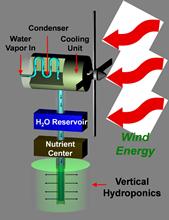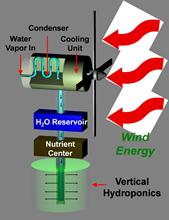
The Sustainable Rooftop Garden
It is always astonishing to recall that the Earth is covered by 70 percent water, and yet 97 percent is salt water. The three percent that is fresh is mostly trapped as ice, leaving a paltry 0.7 to 1.5 percent as fresh water that is accessible as groundwater or atmospheric moisture. Almost every facet of our lives depends on potable water -– everything from agriculture to medicine relies upon this precious commodity. Today, the rapid global population growth and industrialization rates of developing countries are applying an ever-increasing pressure on the capabilities of mankind to accommodate the fresh water needs of the planet.
Clean water generation for agriculture has been one of the limiting factors for developing nations, especially in arid climates. Additionally, lack of arable land, poor infrastructure and contaminated water hinder the development of micro-irrigation, and self-sustaining communities on a global scale. For example, parts of West Bengal's ground water have near-lethal levels1 of arsenic at 300 μg/L, while the World Health Organization suggests2 levels below 10 μg/L. With clustered high-growth rates expected in areas with high-population densities, feeding these communities becomes an ever increasing challenge. This was the inspiration for the GreenTop technology platform, a device that combines water condensed from atmospheric moisture with hydroponic agriculture to create an affordable, self-sustaining vertical-rooftop garden for use in developing nations. This affordable, scalable technology relies solely on renewable energy and offers high urban population densities the ability to grow food using existing infrastructure.
The Dow Sustainability Innovation Student Challenge Award (SISCA) team, comprised of Ph.D. chemists and MBA students at Northwestern University, assembled to create the GreenTop team. GreenTop combines a nascent technology field: condensing atmospheric moisture into water via energy generated by a small wind turbine, which then feeds into a nutrient source to carry the enriched water to a hydroponic honeycomb in order to support the growth of vegetables and fruits. This technology is affordable, with a one-time fixed cost for the wind turbine. The plants and nutrients are all locally generated, and the nutrients used to enhance the water can be recycled from the crop compost made from the GreenTop platform. This design aligns with global sustainability goals, put forth by thought leaders, such as Dow's 2015 Sustainability Goals, wherein GreenTop addresses food and water generation by utilizing renewable power for local communities in developing nations in the midst of rapid climate change.
 The residential wind turbine can be supported on most rooftops that have a capacity to support approximately 500 pounds (227 kg). The wind turbine (depicted in the graphic to the left, Figure 1), approximately 10‒15 feet tall, is capable of generating approximately 1 kW of power. This energy is used to power a cooling unit composed of a recycling ethylene-glycol pump, an inexpensive and commonly used technology to cool coiled tubes to −20 degrees C. This cooling unit allows moisture to condense from atmospheric humidity, creating a continual stream of water. Based on humidity levels of 40 percent in semi-arid climates, the pump is able to generate two liters of water per hour at wind speeds of 3 meters/second (7 mph).
The residential wind turbine can be supported on most rooftops that have a capacity to support approximately 500 pounds (227 kg). The wind turbine (depicted in the graphic to the left, Figure 1), approximately 10‒15 feet tall, is capable of generating approximately 1 kW of power. This energy is used to power a cooling unit composed of a recycling ethylene-glycol pump, an inexpensive and commonly used technology to cool coiled tubes to −20 degrees C. This cooling unit allows moisture to condense from atmospheric humidity, creating a continual stream of water. Based on humidity levels of 40 percent in semi-arid climates, the pump is able to generate two liters of water per hour at wind speeds of 3 meters/second (7 mph).
The GreenTop system makes use of this "free" water and applies it for vertical hydroponic agricultural growth, thereby increasing agricultural yield density and decreasing net weight by not requiring soil or external land. The water flows into a water reservoir, which then slowly percolates to a sealed module containing local compost, where it extracts nutrients -– similar to how a coffeemaker works. A special nanoporous permeable membrane would then remove pathogens and fine particulate matter, allowing the nutrient-soaked water to flow down the turbine support rod to a polymer-matrix honeycomb structure supplying garden-variety plants. This hydroponic technique has been proven to be highly effective in growing vegetables and fruits, as it maximizes plant growth by allowing nutrient-enriched water uptake, while minimizing the weight from soil. Additionally, the architecture of the device maximizes space by utilizing the volume of space associated with the turbine's physical footprint. Efficiency combined with affordability makes a sustainable solution.
The team has estimated that the GreenTop device can be produced for approximately $800 U.S., and the price would drop if produced on a larger scale. Under optimal growing conditions, GreenTop would pay for itself within three years. The engineering is modular, thus if components succumb to natural wear and tear, the cost of replacements is inexpensive. This is ideal for developing nations such as Bangladesh and North African countries, where land is scarce, groundwater may not be potable, and the climate is arid.
Moving forward, the GreenTop team looks to develop a prototype of the wind-turbine hydroponic agriculture unit, then seek investment to scale the idea for a pilot run. Nepal would be an ideal location to pilot the program and the team plans to work closely with humanitarian agencies to measure the outcomes. GreenTop is actively seeking interested parties for collaboration, with the goal to gain additional support for prototype modeling and development. GreenTop is a sustainable solution that can be easily deployed and enables micro-agriculture to augment the food supply chain in developing nations. To learn more, please visit http://www.greentopwind.com.
References
1. A. Chakraborti, et al. Arsenic in Ground Water in Six Districts of West Bengal, India: the Biggest Arsenic Calamity in the World. Analyst, 1995, 120, 644−650.
2. A. H. Smith, et al. Contamination of Drinking-Water by Arsenic in Bangladesh: A Public Health Emergency. Bulletin of the World Health Organization, 2000, 78, 1092−1103.
Posted by Ashish Basuray on Oct 31, 2012